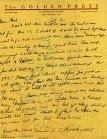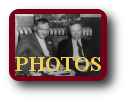National Recovery Review Board
"Like sentinels at a munition plant in wartime, guards stood watch before the locked doors of the printing office at the Department of Commerce for 18 hours one day last week. Behind the doors political dynamite was in manufacture, the long-awaited report by Clarence Darrow and his special board on the operations of NRA as they affected the small industrialist and businessman was being mimeographed. Also being mimeographed under guard were the dissenting report of John F. Sinclair of Manhattan, newspaper financial columnist and member of the Darrow Board, and the caustic retort of General Johnson. At the zero hour 150,000 words of controversy were dumped upon the public. Vitriolic bomb shells of recrimination burst in the camps of Johnson and Darrow while Sinclair's trench mortar added to the loud discord. By and large the U. S. took the bombardment without flinching."
– Recovery: Darrow Report, TIME, May 28, 1934.
|
Lecture given by Lowell B. Mason about Clarence Darrow and the National Recovery Review Board. Mason worked with Clarence Darrow on this board. Courtesy of The University of Chicago Law School Record.
From the Internet Archive.
Codes of Fair Competition, Nos. 58 - 110, Volume 2 (1934).
From the Internet Archive.
Codes of Fair Competition, Nos. 111-150, volume 3 (1934).
This volume contains the code for the motion picture industry. The National Recovery Review Board, chaired by Clarence Darrow, received more complaints against the motion picture code than any other code they reviewed. The Board's report on the motion picture code was included in its first report. From the Internet Archive.
Codes of Fair Competition, Nos. 151-195, volume 4 (1934).
From the Internet Archive.
Codes of Fair Competition, Nos. 196-244, volume 5 (1934).
From the Internet Archive.
Codes of Fair Competition, Nos. 245-286, volume 6 (1934).
From the Internet Archive.
Codes of Fair Competition, Nos. 287-329, volume 7 (1934).
From the Internet Archive.
Clarence Darrow's Testimony before Senate Committee Investigating the National Recovery Administration.
The controversy created by the National Recovery Administration and the National Recovery Review Board prompted the Senate to pass Resolution 79 under which the Senate Committee on Finance would undertake an investigation of the National Recovery Review Board. Clarence Darrow was called to testify on March 20, 1935.
Investigation of the National Recovery Administration: Hearings Before the Committee on Finance, Part 6.
Part of the Senate Committee on Finance hearings held pursuant to Senate Resolution 79 to investigate the National Recovery Review Board. Part 6 covers April 13, 15, 16, 17 and 18, 1935 and contains the dissenting report of John F. Sinclair.
The notice also mentions Darrow has been lecturing on behalf of liquor dealers. From The Shop Review.
Photos
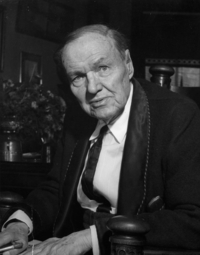 Clarence Darrow circa 1930s. |
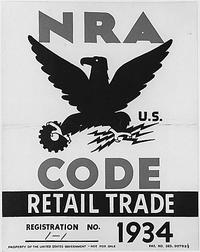 NRA Blue Eagle Poster ca. 1934. Displayed by businesses to show support for the National Recovery Administration program. National Archives and Records Administration, ARC Identifier 195507. Franklin D. Roosevelt Library, Hyde Park, NY. Item from Collection FDR-PHOCO: Franklin D. Roosevelt Library Public Domain Photographs, 1882 - 1962. |
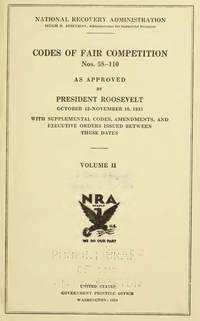 Codes of Fair Competition, No. 58-110, Volume II. Title page from volume II. |
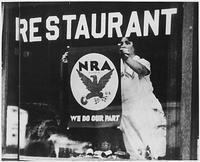 NRA: Blue Eagle Emblem. Poster displayed in restaurant window stating their participation and support for National Recovery Administration program. National Archives and Records Administration, ARC Identifier 196519. Franklin D. Roosevelt Library, Hyde Park, NY. Item from Collection FDR-PHOCO: Franklin D. Roosevelt Library Public Domain Photographs, 1882 - 1962. |
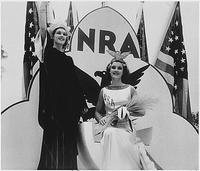 Posed Shot of Two Woman Dressed in Costumes Promoting National Recovery Administration Programs c. 1934. The photo includes Blue Eagle Emblem, NRA letters, and American flags in the background. National Archives and Records Administration, ARC Identifier 197272. Franklin D. Roosevelt Library, Hyde Park, NY. Item from Collection FDR-PHOCO: Franklin D. Roosevelt Library Public Domain Photographs, 1882 - 1962. |
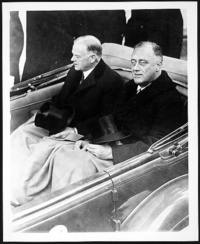 President Herbert Hoover Escorting Franklin D. Roosevelt on the Way to U.S. Capitol for Roosevelt's Inauguration, March 4, 1933. The National Recovery Review Board was established by President Franklin Roosevelt through Executive Order 6632 on March 7, 1934: "By virtue of the authority vested in me under the provisions of Title I of the National Industrial Recovery Act of June 16, 1933 (ch. 90, 48 Stat. 195), and in order to effectuate the purposes of said Title, I hereby establish an organization which shall be known as the National Recovery Review Board. The following persons are hereby appointed to serve as members of the said Board: Clarence Darrow, Fred P. Mann, Sr. Samuel C. Henry W. W. Neal, John F. Sinclair, W.O. Thompson." Clarence Darrow headed the Review Board in the last major activity of his professional life. Library of Congress Prints and Photographs Division, LC-DIG-ppmsca-19179. |
 Franklin Delano Roosevelt. When he was Governor of New York, Franklin D. Roosevelt, wrote a letter to Clarence Darrow on February 23, 1931 in which he said "I wish much that the next time you come East you would stop off in Albany to have a talk with me. I should like to have your opinion on a number of matters for, as you know, we in the State of New York are facing a decision on a good many things which will have a definite effect on future policies throughout the country." LC-USZ62-117121, Library of Congress Prints and Photographs Division. |
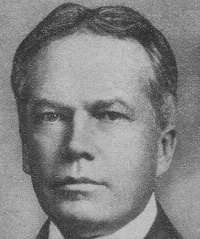 Charles Edward Russell c. 1919. Photo from http://en.wikipedia.org /wiki/File:Russell-charles -edward-1919.jpg |
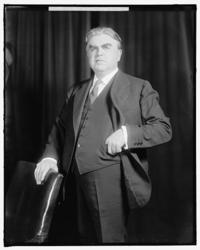 John L. Lewis. John L. Lewis, president of the United Mine Workers of America from 1920 to 1960, claimed that Clarence Darrow and the National Recovery Review Board were getting their information from "irresponsible malcontents, sweatshop employers and business interests which had lost special privileges." Lewis accused Darrow of having "pandered to the worst elements in our political and economic life." Library of Congress Prints and Photographs Division, LC-DIG-hec-21637. |
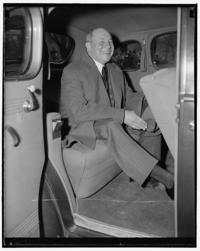 Donald R. Richberg. Donald Richberg, a key aide to President Roosevelt, helped write the National Industrial Recovery Act and he served as general counsel and executive director of the National Recovery Administration. Richberg had known Clarence Darrow for years and he recommended that Darrow be appointed to the National Recovery Review Board. Caption for photo: "Former NRA coordinator discusses oil seizures with Roosevelt. Washington, D.C., April 18. Donald R. Richberg, former NRA coordinator and now an oil company negotiator in an attempt to straighten out the problems involved in the Mexican seizures of American oil properties. He said that his visit was only to make a routine report." Library of Congress Prints and Photographs Division, LC-DIG-hec-26496. |
 General Hugh S. Johnson. President Roosevelt appointed Hugh S. Johnson as Director of the National Recovery Administration (NRA). An important part of the NRA's responsibility was the creation and enforcement of "codes of fair competition" between various industries. But the codes and the NRA were heavily criticized. In response, in March 1934 President Roosevelt created the National Recovery Review Board to review the codes and report its findings to the president. Roosevelt picked Clarence Darrow to chair the board. But the Darrow board antagonized the Roosevelt administration with its critical reports and Darrow and Johnson publicly sparred. Caption for photo: "Former NRW administrator urges independent course for United States abroad. Washington, D.C., April 24. Appearing as a witness before the Senate Foreign Relations Committee today, Gen. Hugh S. Johnson, former NRA administrator and now a newspaper columnist, urged an independent course for the U.S. abroad. He said only the safe course for this nation now was to rely upon its own strength." Library of Congress Prints and Photographs Division, LC-DIG-hec-26545. |
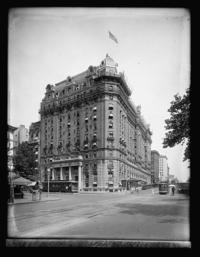 Willard Hotel [between 1921 and 1922]. Clarence Darrow's favorite hotel when he was in Washington D.C. After Darrow and several others were appointed to the newly formed National Recovery Review Board in March 1934 the board conducted its work in the Willard Hotel. Library of Congress Prints and Photographs Division, LC-DIG-npcc-30318. |
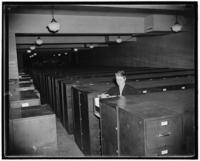 Last of the N.R.A. Washington, D.C., October 26, 1938. "Mrs. Mildred S. Steinmetz, who started in 1933 as Filing Department Chief with 135 assistants, is now the sole chief of the defunct National Recovery Administration. In comparison to 5400 employees on NRW payroll at one time, Miss Steinmetz has to get along with only seven assistants to help her care for half an acre of filing cabinets packed to the limit with 40,000,000 pieces of correspondence, reports, studies and other data. From time to time, universities, libraries, newspapers, industries, and nearly every department of the government call on these files for information." Library of Congress Prints and Photographs Division, LC-DIG-hec-29155. |
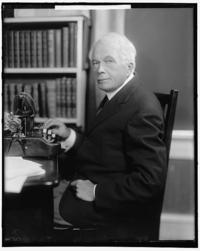 Charles Edward Russell. Charles Edward Russell (1860 - 1941) was a journalist, author, and activist. Born in Davenport, Iowa, he was the son of the abolitionist editor of the Davenport Gazette. He moved to Minneapolis in 1881 to write for the Minneapolis Journal which would later become part of the Star Tribune. During the next twenty years he worked for the Detroit Tribune, the New York World, the New York Herald and the Chicago Examiner. He was also a cofounder of the National Association for the Advancement of Colored People (NAACP) in 1909 and a member of the Socialist Party prior to World War I. Russell became one of the most prolific and controversial of the muckraking journalists. Russell won a Pulitzer Prize in 1928. Clarence Darrow was good friends with Russell and brought him in to help Darrow conduct work on the National Recovery Review Board in 1934. The board was appointed by President Franklin Roosevelt to study the fair competition codes created by the National Recovery Administration. Library of Congress Prints and Photographs Division, LC-DIG-hec-20122. |
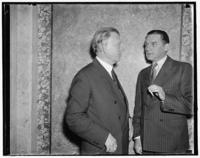 Senator William E. Borah and Senator Gerald P. Nye. Senator Gerald Nye of North Dakota and Senator William Borah of Idaho were the most vocal critics of the National Recovery Administration (NRA) and the fair competition codes because they believed the codes adversely impacted small businesses. Senator Nye and the director of the NRA Hugh Johnson worked out a proposal to establish a board to receive and investigate complaints from small businesses. This board became the National Recovery Review Board and Clarence Darrow was later chosen to chair the board. Library of Congress Prints and Photographs Division, LC-DIG-hec-22663. |
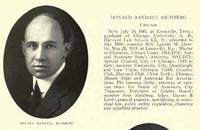 Donald R. Richberg. Donald Randall Richberg (1881 - 1960) was an attorney, civil servant, and author who served as a key aide to President Franklin D. Roosevelt. Significantly, Richberg helped write the National Industrial Recovery Act and he served as general counsel and executive director of the National Recovery Administration (NRA). Richberg, who had known Clarence Darrow for years, was instrumental in getting Darrow appointed to the National Recovery Review Board that was setup to review the Codes of Fair Competition enforced by the NRA. Before working in the Roosevelt administration, Richberg earned a reputation as a labor lawyer and worked on behalf of railroad unions as part of the American Federation of Labor. Richberg is credited with drafting and helping to get enacted the Railway Labor Act of 1926. He also helped craft the Norris-LaGuardia Act and the Taft-Hartley Act. Photo from the Bench and Bar of Illinois (1920). |

